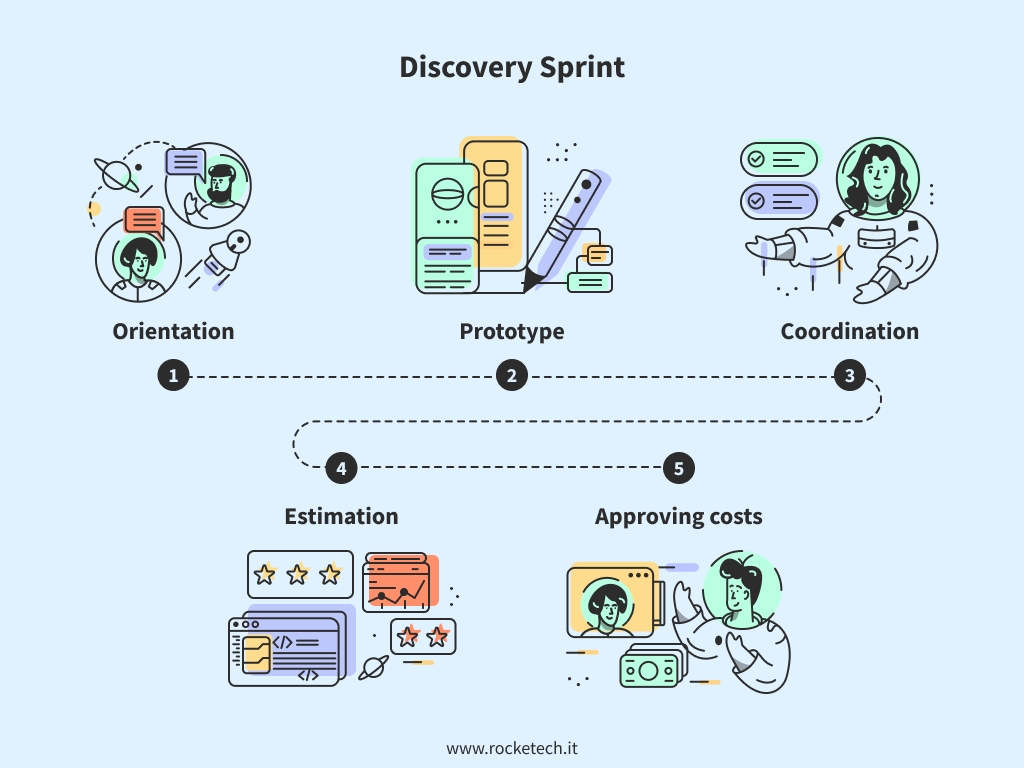Discovery Phase: What Is It and Why Should You Care?

Discovery Phase: What Is It and Why Should You Care?
Custom software is one of the most advanced instruments for business. It allows organizations to get a first-class solution tailored to their needs. However, this process has one crucial step that enterprises frequently overlook – the discovery phase. And it has enormous importance for creating quality digital solutions.
If companies neglect their discovery phase, there are serious consequences. According to the data from Wellingtone, only 43% of projects mostly or always go on a budget.
If you run a startup or a reputable company, such tremendous overspending can result in significant obstacles. Therefore the discovery phase of a project is crucial for creating any custom software.
Looking for a company that prioritizes a discovery phase? Find a product development company to partner with on The Manifest.
Jump to:
- The discovery phase concept
- Why do you need a discovery phase?
- What teams are involved with the discovery phase?
- Discovery phase stages
- Discovery phase advantages
- Discovery phase outcomes
The Discovery Phase Concept
During the discovery phase (or scoping phase), the dedicated team learns more about the future solution and determines all necessary functions.
Founders, business analysts, and UX researchers figure out what the product should be and what goals the product (or service) will have.
The most commonly conducted activities in a discovery phase include:
- Problem interviews
- Building user personas
- Competitor analysis
With these assets, business analysts create technical requirements for developers.
There may also be a situation when it is required to make additions to the software being developed. The scoping phase allows the developers to learn what updates you can make, where they would go, and how they will impact the entire process.
But most importantly, it is the first step to achieving the product-market fit. The problem interviews help define a problem and if potential users are aware of it.
Therefore, you should gather the opinions of potential users. It allows them to create a valuable product and not become one of the around 90% of startups that failed.
If you decide to skip this part, you should take it halfway through the project.
Such an approach will help you define all mistakes you made at the start and fix them before deploying the digital product.
Why Do You Need a Discovery Phase?
The discovery phase activities may be too complicated for even experienced entrepreneurs.

However, the stage includes the following long-standing actions:
- Meeting the customer and learning the initial idea (questionnaire, in-person meetings, brainstorming, idea pitching, etc.).
- Talking about the current business model and the concept of the future solution. Here you can combine the customer's needs and expectations with realistic time frames.
- Analyzing the closest competitors. It helps define their weaknesses and strengths and develop a product features specification.
- Researching the target audience. This activity is vital because it allows defining a niche of your digital solution and creating a list of software features. The best way is to conduct in-depth problem interviews since they can show customer scenarios your competitors do not have. Organizing these interviews properly will better understand the user needs and ensure the product/market fit.
- Defining the scope of the work.
- Looking for the most appropriate solutions to solve clients' problems.
- Setting tasks with well-defined timelines and dedicating a team of specialists to the development process.
- Getting finished business requirements to documentation and technical implementation proposal.
You will deliver more value if you cut the budget and timeline via the scoping process. According to Axelos, 47% of project managers believe in it.
What Dedicated Team Members Are Essential for The Discovery Phase?
After we learn the purpose of the discovery phase, let’s go to the next part.
Regardless of the scope or type of digital product, the scoping process must be carefully planned.
You should add a particular number of employees to this development stage. It will help ensure that all parties have the correct data to move on, so the presence of the following specialists is mandatory.
Business Analysts
They can indicate many aspects of a company's work. Business analysts can advise on implementing or improving business processes, identify the most vital requirements and evaluate the impact of the digital solution on the entire company.
Involving a business analyst is often invaluable for the quality scoping process because they set a technical requirement for the developers' team.
UI/UX Designers
These employees are responsible for the discussion of the project details.
Further, they are assigned to bring all discussed features to life. In this case, UI/UX designers conduct quantitative surveys, problem interviews and customer research. The latter two are especially important because the results of interviews and user personas help to create a functional MVP.
But the primary role is behind the head UI/UX Designer as they listen to the customer requirements and generate a whole project idea. These functions are comparable to an architect who plans a specific building or an engineer designing a sophisticated device.
DevOps Specialists
They are responsible for building and setting up digital solutions and infrastructure. For example, their duties include looking for ways to automate and improve development activities, learning the founder's needs and conveying them to developers. DevOps engineers should also examine and test the code before deployment.
Software Architects
Involving a software architect is essential because this employee is responsible for developing and testing all digital solutions. Their participation in the discovery phase of a software project allows developers to understand the project goals better. In addition, a software architect can evaluate the digital solution functionality and complexity.
Developers
They are directly responsible for creating the full-fledged product. Developers are assigned to write the code for your project software and infrastructure and test it to ensure it works.
Scrum Master
This employee acts as the mentor for the dedicated team employees. Scrum Master (SM) ensures that developers follow the same track as planned. When any conflicts occur, the scrum master helps the team resolve them.
6 Core Stages of the Discovery Process
The outline of the discovery phase in software development is standard regardless of the project's size.
Here are 6 essential stages:
- Create a list of stakeholders. It should include all categories that will develop or leverage the finished solution (POs, PMs, SMs, founders, end-users, etc.).
- Meet the dedicated team. As a founder, you need to prepare for a discussion properly. For example, present a clear vision of the digital solution and provide answers to all the questions. Moreover, help your team members to meet each other to ensure that all parties are heard.
- Review existing documents and studies. You also have to provide business analysts with relevant documents for market surveys, if there are any.
- Create a user profile by conducting problem interviews. It will help to determine the final goals and the necessary tools.
- Research your competitors. During this process, you should look for the strong and weak points of the existing solutions. This data will help define the niche of your digital solution and develop a software requirements specification.
- Specify the budget and timeframes for all development stages. This approach helps to save money in the future and create first-class products.
All these actions are vital for determining the idea of your digital solution and understanding what comes after the discovery phase. After that, you can start to develop your product.
The Main Advantages of a Discovery Phase
The discovery process has some significant benefits. If you decide to skip this phase, you lose your chance to:
Minimize Risks
A team of qualified specialists helps companies implement the time- and money-saving approach. Moreover, this collaboration allows avoiding the risks connected with:
- A small market volume
- A misunderstanding of the product-market fit
- The trouble with time and money management
- Wrong choice of technological solutions
- Expensive maintenance
- Communication failure
Hence, companies prefer to hire dedicated teams. They help to reach particular business goals with minimal risks.
Establish a Roadmap
You should consult with the team members and create a clear timetable with all goals, results, and precise timelines.
Gain Trust
This advantage has three critical moments.
- You will get a prototype to attract investors to your digital product.
- Start with collecting feedback from your focus groups because it allows you to create an MVP in the future. Talk about real-world problems your potential users deal with frequently enough.
- You can draw conclusions about your team and decide on further cooperation.
It is another argument in favor of a dedicated team. Therefore, take the selection and hiring process pretty seriously.
The Discovery Phase Outcome
Once you finish the scoping process, all parties should have a complete picture of the future software and possible user expectations. Let's find out the possible outputs from a discovery phase.

1. Making a Prototype
Often, there are some handwritten wireframes of the future interface or experience. If you have an initial vision of the UI/UX, you will be ready to take the first step in creating the first-class user interface of your digital solution.
2. Collecting Feedback on the User Interface Prototype and Experience
Your future customers will be able to test and evaluate your provisional UI/UX. Moreover, you can gather feedback before the final release. These opinions are vital for the success of the future product.
3. Completing Business Documentation
Business requirements documentation sets standards and expectations for the future project. Based on business goals or values, BRD helps all parties to reach a consensus.
4. Choosing the Technology Stack
You will get valuable information about the required platforms, programming languages, and other instruments for creating a top-notch product.
Team Structure
You can assign roles and gather the team before creating the digital solution.
5. Estimating the Proposal
In the discovery phase proposal, you can specify all stages and their costs. It means that all parties have a chance to check the current state of your project.
Discovery Phases Help Determine Product-Market Fit
A discovery phase shouldn't be overlooked in your development process. It's paramount to the success of your product that you properly understand audience preferences and expectations.
Rocketech will provide advanced assistance in creating full-fledged software. We assign a dedicated team to implement your project and avoid all potential risks. If you want to get an innovative digital solution that meets your business requirements, feel free to contact us.